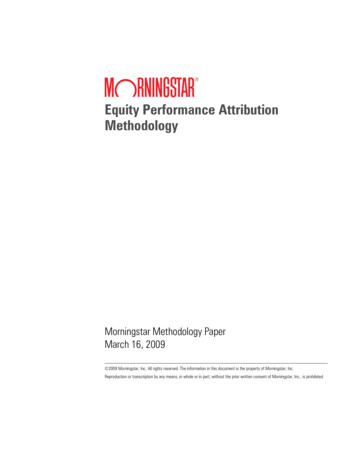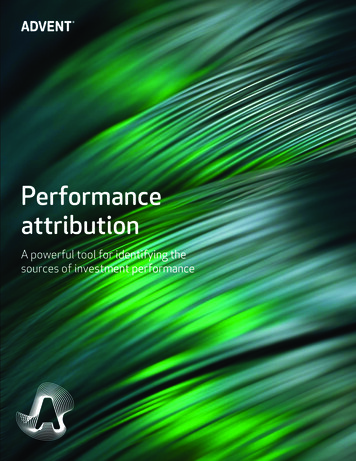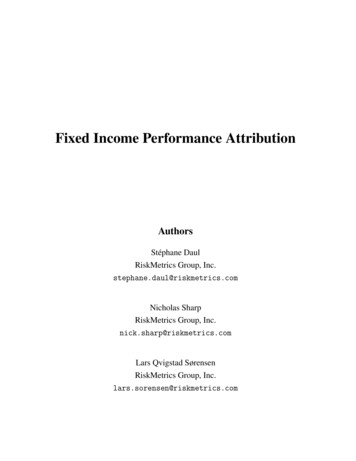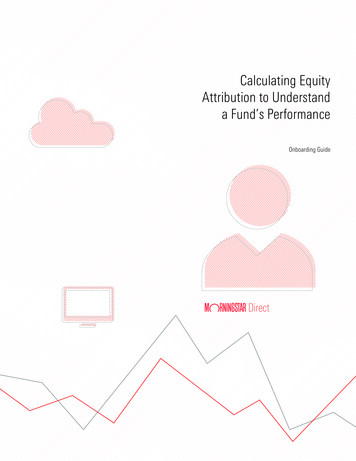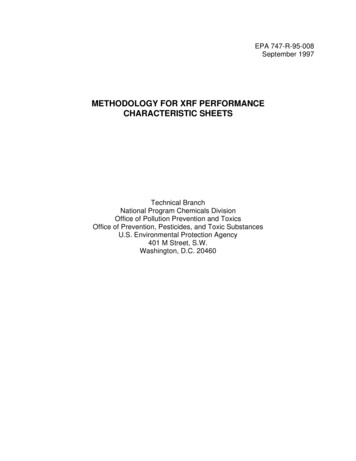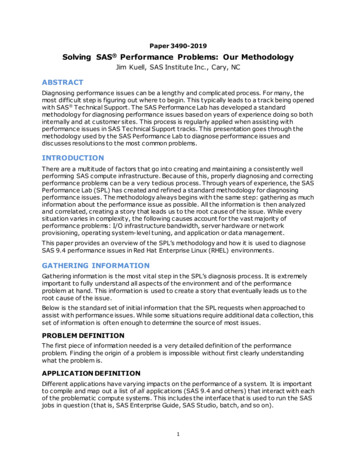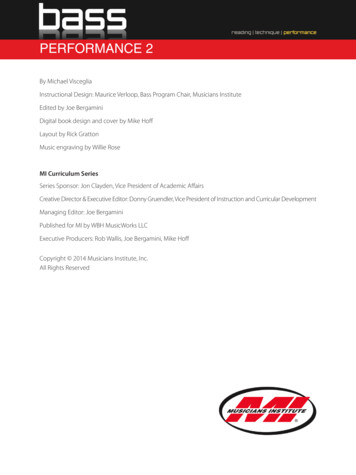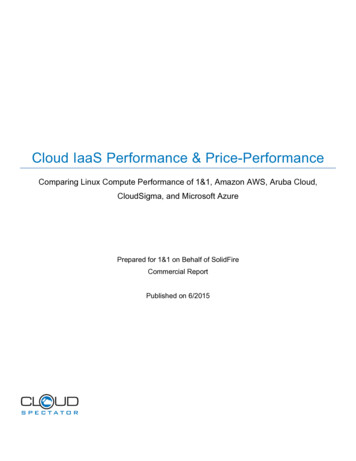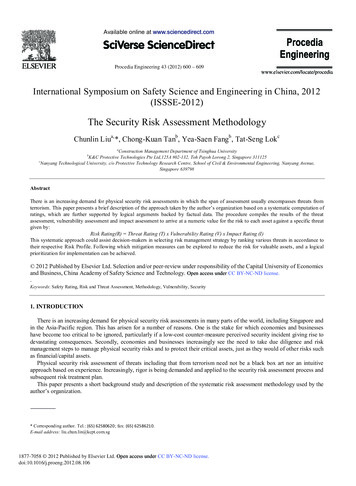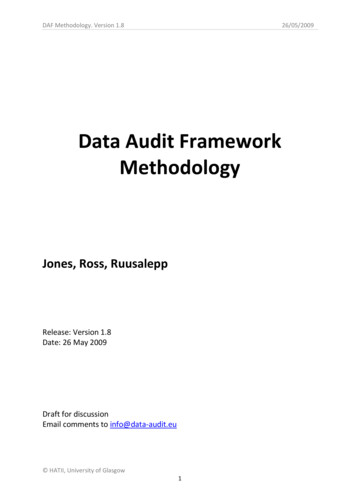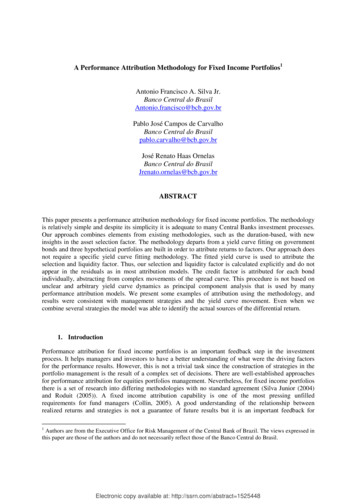
Transcription
A Performance Attribution Methodology for Fixed Income Portfolios1Antonio Francisco A. Silva Jr.Banco Central do BrasilAntonio.francisco@bcb.gov.brPablo José Campos de CarvalhoBanco Central do Brasilpablo.carvalho@bcb.gov.brJosé Renato Haas OrnelasBanco Central do BrasilJrenato.ornelas@bcb.gov.brABSTRACTThis paper presents a performance attribution methodology for fixed income portfolios. The methodologyis relatively simple and despite its simplicity it is adequate to many Central Banks investment processes.Our approach combines elements from existing methodologies, such as the duration-based, with newinsights in the asset selection factor. The methodology departs from a yield curve fitting on governmentbonds and three hypothetical portfolios are built in order to attribute returns to factors. Our approach doesnot require a specific yield curve fitting methodology. The fitted yield curve is used to attribute theselection and liquidity factor. Thus, our selection and liquidity factor is calculated explicitly and do notappear in the residuals as in most attribution models. The credit factor is attributed for each bondindividually, abstracting from complex movements of the spread curve. This procedure is not based onunclear and arbitrary yield curve dynamics as principal component analysis that is used by manyperformance attribution models. We present some examples of attribution using the methodology, andresults were consistent with management strategies and the yield curve movement. Even when wecombine several strategies the model was able to identify the actual sources of the differential return.1. IntroductionPerformance attribution for fixed income portfolios is an important feedback step in the investmentprocess. It helps managers and investors to have a better understanding of what were the driving factorsfor the performance results. However, this is not a trivial task since the construction of strategies in theportfolio management is the result of a complex set of decisions. There are well-established approachesfor performance attribution for equities portfolios management. Nevertheless, for fixed income portfoliosthere is a set of research into differing methodologies with no standard agreement (Silva Junior (2004)and Roduit (2005)). A fixed income attribution capability is one of the most pressing unfilledrequirements for fund managers (Collin, 2005). A good understanding of the relationship betweenrealized returns and strategies is not a guarantee of future results but it is an important feedback for1Authors are from the Executive Office for Risk Management of the Central Bank of Brazil. The views expressed inthis paper are those of the authors and do not necessarily reflect those of the Banco Central do Brasil.Electronic copy available at: http://ssrn.com/abstract 1525448
building new strategies, communicating across institution and clients, identifying skills and linking risksfactors to performance.There are some providers of fixed income performance attribution systems but the models behindmethodologies are not completely open and even understood by users. This lack of transparencyregarding models is a consequence of no universal accepted methodology for performance attribution. Infact, there are not many papers discussing how different methodologies may explain, in a different way,portfolio performance. Many professionals and researchers argue that attribution depends on theinvestment process and therefore we may explain the same things in a different way.The goal of this paper is to discuss a specific methodology for Fixed Income Performance Attribution thatfits a typical Central Bank investment process and to evaluate its advantages and drawbacks. Ourapproach combines elements from existing methodologies, such as the duration-based, with new insightsin the asset selection factor. This combination of ideas makes this approach very close to investmentprocesses of several institutional investors. The methodology is based on a benchmark of governmentbonds and on an actual portfolio of government bonds and credit products.The methodology departs from a yield curve fitting on government bonds. Based on a yield curve fitting,three hypothetical portfolios are built in order to attribute returns to factors. This performance attributionprocedure is relatively simple and does not need any information but bonds prices and descriptions.Our approach does not require a specific yield curve fitting methodology. The fitted yield curve is used toattribute the selection and liquidity factor. The credit factor is attributed for each bond individually,abstracting from complex movements of the spread curve. This procedure is not based on unclear yieldcurve dynamics as principal component analysis that is used by many performance attribution models.In the next section we discuss some features of the fixed income management and the third section showsa literature review of performance attribution for fixed income portfolios. The fourth section discusses thefundamentals of the model we have implemented, and in the fifth section we present some simulationswith real data. Finally, we conclude.2. Fixed Income Portfolio ManagementFixed income assets management comprises a set of strategies for anticipating yield curve movements andfor taking advantage of yield curve shape among others strategies such as securities selection.Performance attribution tries to explain the sources of the return that managers have as an outcome oftheir strategies. We are not going to discuss deeply all the possible strategies in this paper but it is worthto mention some of them.When managers buy a fixed income portfolio, one source of returns is the roll-down effect due to pricesgoing to par as time goes through. The higher assets yields are, the higher returns due to the roll-downeffect are, that we call here as “carry” effect.Fixed income portfolio managers generally try to anticipate parallel yield curve movements by shorteningportfolio duration when they think yields will move up or by increasing portfolio duration when theythink yields will move down. Typically, managers attribute returns that come from the combination of theyield curve parallel movement and the global duration strategy as returns due to the shift of the yieldcurve (in fact the result is a combination of the duration strategy and the yield curve parallel movement).As yields may move in a way different from a simple parallel shift, managers may build the portfoliotrying to anticipate others kind of yield curve reshaping such as flattening, steepening or butterflyElectronic copy available at: http://ssrn.com/abstract 1525448
movements. The results of the strategies that try to anticipate the steepening or flattening of the yieldcurve are attributed for the twist of the yield curve. Some models also attribute the butterfly bets as acurvature contribution. Since the curvature contribution is often small, the portfolio returns due to twistand curvature are aggregated in the yield curve positioning contribution.One important issue in performance evaluation is how to cope with credit products returns. In manyinvestment assessment processes, the extra return generated by allocation in credit products is allconsidered a skill of active managers, even if they simply buy and hold credit products. Performanceattribution models separate credit spread movements and spread carry. Thus, returns originated fromspread movement’s strategies would be active management merit in the short horizon, while spread carryevaluation should only be considered as a result in a very long time horizon basis. Note that performanceattribution only identifies the source of returns. The performance evaluation task is concerned with theconsistency of the results, which is not addressed in this paper.In imperfect markets some bonds may be mispriced regarding the yield curve. Managers may takeadvantage of this kind of situation. The portion of returns that are due to the selection skill of the manageris one source of contribution that frequently appears in the residuals of some performance attributionmodels. The liquidity premium embedded in bond returns is another source that often appears in theresiduals.It is worth to mention that there are different methodologies for calculating the many contributions toexcess returns. Furthermore, fixed income performance attribution methodologies often do not considersome important issues in the investment process. Only as an example, often investors give to the portfoliomanager a benchmark portfolio of only Treasuries and the managers may invest in assets like agencies orcorporate bonds. In this case, the base curve for yield curve bets is the Treasury yield curve. So, theportfolio manager has to build a credit strategy in the credit spreads movement and at the same time buildthe strategy in the Treasury yield curve. Some performance attribution methodologies have difficultiesaddressing this investment process. Although some revaluation techniques discussed in the next section,try to take this problem into account, the way they evaluate shift and twist in the government and in thecredit sector makes not clear the way the two sectors interact.3. Models for Performance AttributionOne of the main issues of models of performance attribution for fixed income is to build a relationshipbetween yield curve movements and portfolio allocation. First of all, it is necessary to model the yieldcurve movement and common approaches focus on parallel shift, slope (twist) and curvature. So, modelscalculate the sensitiveness of the portfolio to these movements. We may build the relationship of yieldcurve changes and portfolio sensitiveness based on the sectors of the portfolio or on the assets.The performance attribution model for fixed income portfolios presented by Dynkin, Hyman andVankudre (1998) try to answer two questions. The first question is related to an allocation decision ineach market segment. To answer this question the benchmark return is divided in sectors and we have touse a hypothetical portfolio that follows the allocation of the real portfolio but has the returns of thebenchmark portfolio in each sector. The second question is concerned on security selection and it focuson how much extra return was achieved due to difference in returns within each market segment. Themodel applies this technique repeatedly in a hierarchical fashion. They need a hypothetical portfolio tocombine portfolio weights with benchmark returns. The return difference between the hypotheticalportfolio and the benchmark is due to the allocation effect. The difference between the real portfolio andthe hypothetical one reflects differences between portfolio and benchmark composition within eachsector. This methodology is based on stratified analysis of assets in buckets and classes. However it doesnot allow a duration neutral analysis of portfolio management.
Breukelen (2000) presents a duration-based approach that calculates the duration contribution andcorrects returns to calculate allocation and selection. This approach does not calculate the yield curvepositioning effect. However, Silva Jr. (2004) presents a solution to this problem that is based on theassumption of a linear relationship for adjusting returns based on the duration. The main constraint of thisapproach is the reliance on a linear relationship for adjusting returns based on the duration.Principal component analysis (PCA) is a statistical methodology used by some software providers tocompute performance attribution. The aim of PCA is to identify most important factors that explain yieldcurve movements. PCA is a general approach that describes changes in the shape of the yield curve interms of movements in several directions and sometimes the individual curve movements do not have astraightforward interpretation (Colin, 2005).There are other approaches for yield curve decomposition as we may see in Roduit (2005). The authordescribes an empirical method presented by Dynkin, Hyman and Konstantinovsky (1998). The changes inthe yield curve are explained by three movements: shift, twist and butterfly. The parallel shift iscalculated based on the average yield changes over five references maturities. The twist of the yield curveis calculated based on the difference between change in the yield curve in the 30 years sector and 2 yearssector. Half of this difference is applied at the 30 years sector as a moving up and half is applied at the 2years sector as a moving down. The butterfly (curvature) is the average of the changes in the yield curvein the 30 years sector and 2 years sector minus the changes in the yield curve in a pivot point (the 5 yearssector). One third of this result is applied as a moving up at the 2 and 30 years sectors and two thirds areapplied as a moving down at the pivot sector. Note that at the end we have to apply the calculated changesin the yield curve in a revaluation procedure similar to the PCA approach. The portfolio sensitiveness toeach change will give the attribution results. However, the intuitiveness and flexibility of the empiricalapproach allow the portfolio manager to customize the attribution relative to his bets.Srichander (2001) combines features of PCA and empirical procedures, showing that the risk factors aregrouped in categories in order to identify the contribution of the various investment decisions to theexcess return of the portfolio compared to the benchmark. It is worth to mention that after identifying andquantifying the factors we must revaluate the portfolio for each factor. So, the portfolio sensitiveness forthe first risk factor, for instance, gives the performance attribution result to that factor.Colin (2005) and Roduit (2005) discuss another way to model yield curve changes based on polynomialregression of degree two. We fit the yield curve at the beginning and at the end of the period. Thedifference between the parameters of the zero degree gives the shift of the yield curve. Multiplying thedifferences at the others parameters by each yield curve sector in the polynomial gives the twist andcurvature changes of the yield curve. Despite its intuitiveness the polynomial approach has the drawbackthat yield curve may not be well fitted by a polynomial of second order. Colin (2005) discusses thealternative of fitting the yield curve using the Nelson & Siegel (1987) approach. Note that despite the factthe author fit the yield curve different from the polynomial approach the main structure of the methodremains the same.It is worth mentioning that the majority of the discussed approaches rely on the availability of the yieldcurve for each class of credit products to measure the credit effect. Colin (2005) points that a mismatchbetween the available credit curves and the actual bond credit level may turn into a problem for runningperformance attribution.A very well known problem with performance attribution is the dynamic of the portfolio. When managersbuild strategies portfolio does not remain static since there are many buy/sell operations. This problemmay not exist if managers buy and hold the portfolio until the end of the evaluation time horizon. As it is
often not possible performance attribution calculations may suffer from this dynamic. One possible wayto solve this problem is to segregate the results of these operations in a daily basis.Aggregation of return over time is another well known problem in performance attribution. This problemarises because we define portfolio return in a single day as the sum of some contributions (arithmetically).The geometrically compounded portfolio return for two days does not correspond to the sum ofgeometrically compounded portfolio contributions. Despite that many authors suggest ad hoc proceduresto deal with this problem there is not a generally accepted methodology. One alternative is to considerdaily portfolio return as a geometrical composition of the contributions.Other two known problems with performance attribution are discussed, for instance, in Singer et al.(1998): cross-product effects and the simplifying assumptions made when collecting performance data.Also many yield curve attribution usually generates residuals, since they approximate returns by two orthree movements/factors, but results from high order are not considered. All these above mentionedproblems generate residual effects that many models aggregate in the selection and liquidity effect. Inother words, the selection effect is calculated by difference. Colin (2005) refers to this solution as a catchall term for the selection and liquidity effect.As we mentioned before, there is no standard model for performance attribution. Furthermore, it is worthto mention that performance attribution is not an easy task and it is embedded with several assumptions.Many institutions buy performance attributions packages since there are many in the investment industry.Buying a system may be the right choice when we do not have resources to develop and to maintaincomputer packages. Nevertheless, when we build internally our solution we have a better understandingof the financial problem and we understand better the models constraints. Building a computer solutionallows us to customize our model and reports to the investment process of the organization. If you buysoftware it is harder to change the solution to have a better fitting to your organization. We understandthat the effort of models research, development and discussion is very worth to have a betterunderstanding of the financial variables behavior what makes investment participants more comfortablewith new products and strategies. In the next section we present a methodology of performance attributionthat combines the duration based approach and the yield fitting methodology.4. Methodology DescriptionWe describe the methodology using an actual portfolio return (A) and a benchmark portfolio return (B) ofgovernment bonds. The actual portfolio may include credit products. The methodology relies on theconstruction of three hypothetical portfolios in order to attribute returns. The methodology also requiresthe use of a model to fit the yield x duration curves. Although we use in our examples the Svensson2method, any other fitting model may be used.The first step of the methodology is to fit a yield curve using government bonds. For the first hypotheticalportfolio (H1), returns of both government and credit bonds of actual portfolio are calculated using thefitted yield curve for the durations of the actual bonds.The return of the second hypothetical portfolio (H2) is evaluated by using the fitted curve to calculatereturns of the Benchmark portfolio. So, the differential return between these two hypothetical portfolios isdue to duration and yield curve strategies in the government yield curve. Duration contribution iscalculated by standard procedures based on portfolios durations and yield curve movement in thegovernment sector. Note that H2-H1 is the result of managers’ strategies on the Government yield curve.We may use any methodology to fit the yield curve. The difference between this methodology to the2The Svensson (1994) method adds a second curvature factor to the Nelson and Siegel (1987) method.
empirical, polynomial or the others yield curve fitting approaches is that we do not attribute based on theparameters of the yield curve model. Furthermore, we consider that parallel movement bet is based on thebenchmark duration. This assumption matches in a more realistic way many investment processes.The return of the third hypothetical portfolio (H3) is calculated as follows: for credit products, returnscalculated using the fitted Government bonds yield curve; for government bonds, we use the actualreturns. The difference between returns of the third hypothetical portfolio and the first one gives selectionand liquidity effect
A fixed income attribution capability is one of the most pressing unfilled requirements for fund managers (Collin, 2005). A good understan
